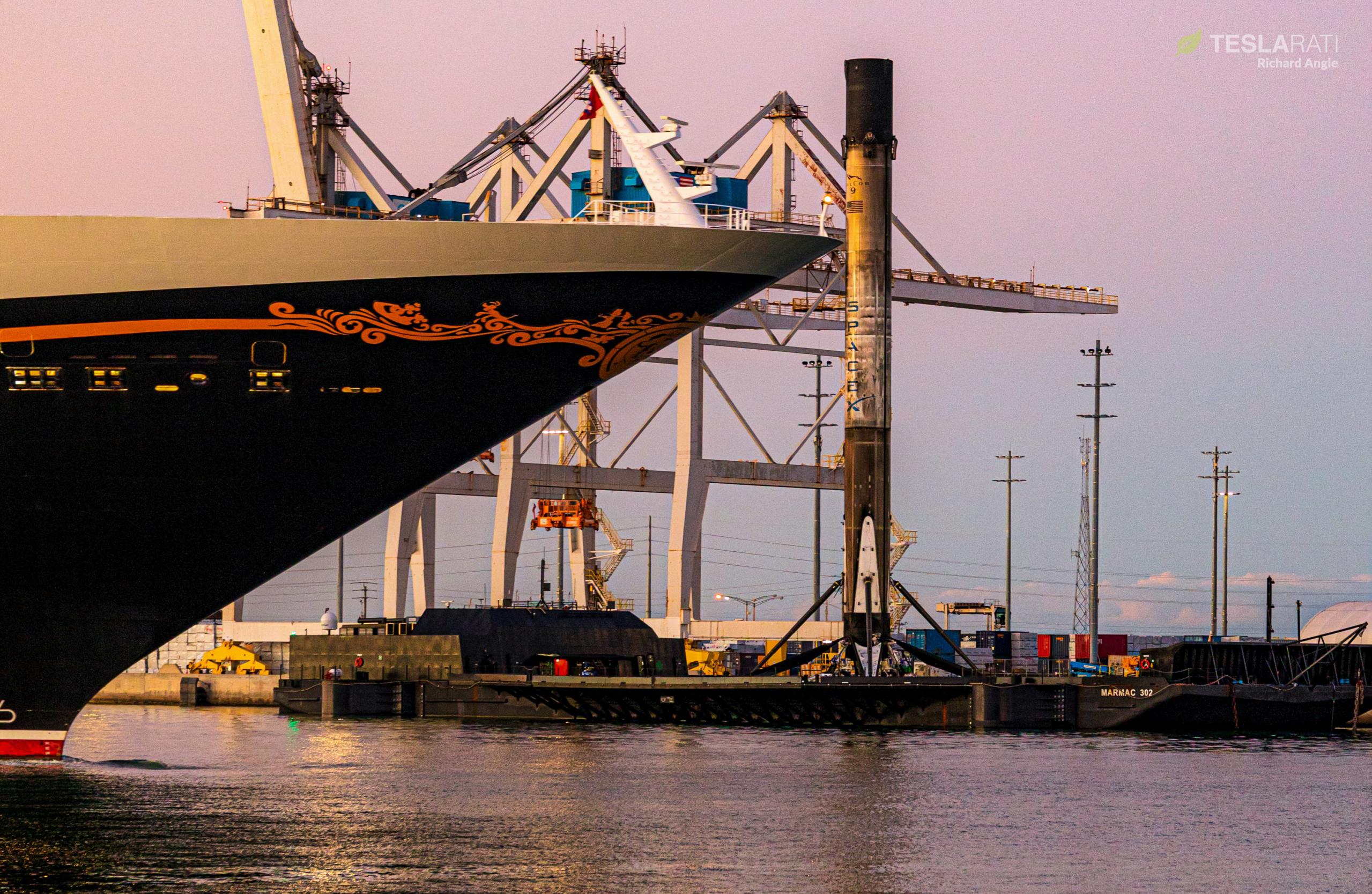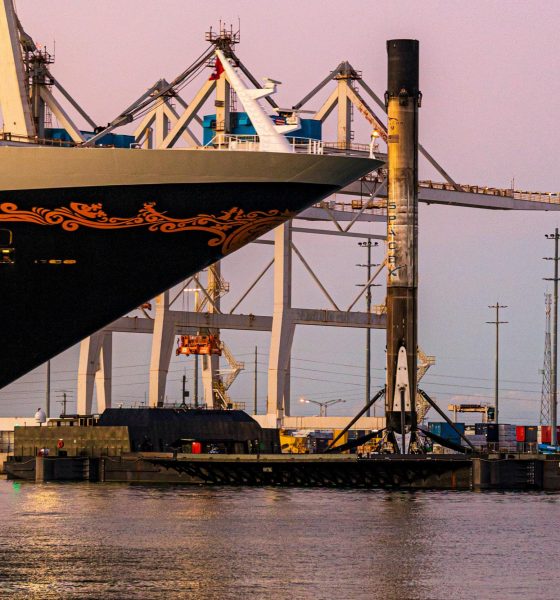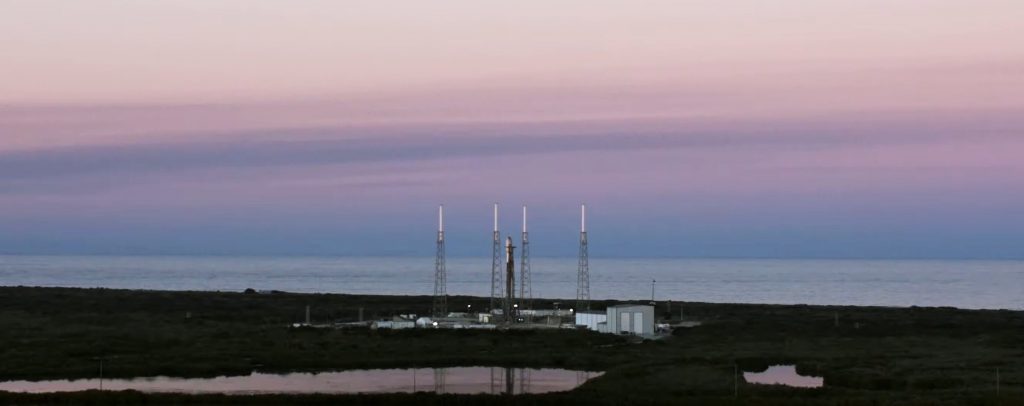

News
SpaceX Falcon 9 launch scrubbed by wayward cruise ship
For the fourth time in four days, SpaceX has been forced to scrub Falcon 9’s launch of an Italian Earth observation satellite.
This time, however, rather than the poor weather that aborted Falcon 9’s first three launch attempts, the fourth scrub was caused by a cruise ship fouling the range and trespassing inside a US Coast Guard keep-out zone that’s been public for the better part of a week.

By all appearances, the ship responsible appears to have been Royal Caribbean’s Harmony of the Seas, which was headed straight into the Coast Guard’s keep-out-zone about 20 minutes before liftoff and veered south – away from the zone – around 10 minutes later. However, that’s not certain as a large number of cruise ships operate in or around the southeasterly corridor Falcon 9 was scheduled to overly between Florida and the Bahamas, making it possible that a different ship was at risk of entering the keep-out zone dozens to hundreds of miles downrange.

While just a part of rocketry, this scrub was particularly annoying because it came on a day with near-perfect weather after three consecutive weather-related scrubs. The US military’s 45th Space Wing had also explicitly warned boaters and the general public of the unusual southerly launch trajectory and encouraged them to double-check exclusion zones. Further, had Falcon 9 been able to launch, perfectly clear skies and a liftoff scheduled about 15 minutes after sunrise could have created a spectacular light show visible for one or several hundred miles in every direction as Falcon 9 rose back into direct sunlight. The weather forecast on CSG-2’s backup window (6:11 pm EST, Jan 31) still predicts excellent conditions but clear skies are never guaranteed.

Ultimately, a fouled range – and, in general, any non-technical launch delay – is just an inconvenience for SpaceX and its customer. Nonetheless, each scrubbed launch likely costs the company several hundred thousand dollars and wastes hundreds or even thousands of work-hours. Additionally, given SpaceX’s plans for as many as 52 Falcon launches this year, a few days of delays can quickly become a significant issue if repeated multiple times. With any luck, that won’t be the case and CSG-2’s fouled-range delay will be just a fluke for SpaceX and the Florida launch range.
Thanks to the cruise in question, SpaceX now appears likely to have a Falcon 9 launch scheduled on Monday, Tuesday, and Wednesday (Jan 31, Feb 1, and Feb 2). CSG-2 continues to target a 6:11 pm EST (23:11 UTC) liftoff – just on January 31st, this time around. SpaceX will likely delay Starlink 4-7 another 24 hours, pushing the mission to sometime around 2pm EST (19:00 UTC), February 1st. Last, Falcon 9 remains on track to launch the NROL-87 spy satellite mission remains around 12:18 pm PST (20:18 UTC), February 2nd. There’s a possibility that Starlink 4-7 is now NET February 3rd but that has yet to be confirmed. Beyond those three missions, SpaceX has as many as three more Starlink missions tentatively planned for February after NROL-87.

News
Tesla FSD fleet is nearing 7 billion total miles, including 2.5 billion city miles
As can be seen on Tesla’s official FSD webpage, vehicles equipped with the system have now navigated over 6.99 billion miles.

Tesla’s Full Self-Driving (Supervised) fleet is closing in on almost 7 billion total miles driven, as per data posted by the company on its official FSD webpage.
These figures hint at the massive scale of data fueling Tesla’s rapid FSD improvements, which have been quite notable as of late.
FSD mileage milestones
As can be seen on Tesla’s official FSD webpage, vehicles equipped with the system have now navigated over 6.99 billion miles. Tesla owner and avid FSD tester Whole Mars Catalog also shared a screenshot indicating that from the nearly 7 billion miles traveled by the FSD fleet, more than 2.5 billion miles were driven inside cities.
City miles are particularly valuable for complex urban scenarios like unprotected turns, pedestrian interactions, and traffic lights. This is also the difference-maker for FSD, as only complex solutions, such as Waymo’s self-driving taxis, operate similarly on inner-city streets. And even then, incidents such as the San Francisco blackouts have proven challenging for sensor-rich vehicles like Waymos.
Tesla’s data edge
Tesla has a number of advantages in the autonomous vehicle sector, one of which is the size of its fleet and the number of vehicles training FSD on real-world roads. Tesla’s nearly 7 billion FSD miles then allow the company to roll out updates that make its vehicles behave like they are being driven by experienced drivers, even if they are operating on their own.
So notable are Tesla’s improvements to FSD that NVIDIA Director of Robotics Jim Fan, after experiencing FSD v14, noted that the system is the first AI that passes what he described as a “Physical Turing Test.”
“Despite knowing exactly how robot learning works, I still find it magical watching the steering wheel turn by itself. First it feels surreal, next it becomes routine. Then, like the smartphone, taking it away actively hurts. This is how humanity gets rewired and glued to god-like technologies,” Fan wrote in a post on X.
News
Tesla starts showing how FSD will change lives in Europe
Local officials tested the system on narrow country roads and were impressed by FSD’s smooth, human-like driving, with some calling the service a game-changer for everyday life in areas that are far from urban centers.

Tesla has launched Europe’s first public shuttle service using Full Self-Driving (Supervised) in the rural Eifelkreis Bitburg-Prüm region of Germany, demonstrating how the technology can restore independence and mobility for people who struggle with limited transport options.
Local officials tested the system on narrow country roads and were impressed by FSD’s smooth, human-like driving, with some calling the service a game-changer for everyday life in areas that are far from urban centers.
Officials see real impact on rural residents
Arzfeld Mayor Johannes Kuhl and District Administrator Andreas Kruppert personally tested the Tesla shuttle service. This allowed them to see just how well FSD navigated winding lanes and rural roads confidently. Kruppert said, “Autonomous driving sounds like science fiction to many, but we simply see here that it works totally well in rural regions too.” Kuhl, for his part, also noted that FSD “feels like a very experienced driver.”
The pilot complements the area’s “Citizen Bus” program, which provides on-demand rides for elderly residents who can no longer drive themselves. Tesla Europe shared a video of a demonstration of the service, highlighting how FSD gives people their freedom back, even in places where public transport is not as prevalent.
What the Ministry for Economic Affairs and Transport says
Rhineland-Palatinate’s Minister Daniela Schmitt supported the project, praising the collaboration that made this “first of its kind in Europe” possible. As per the ministry, the rural rollout for the service shows FSD’s potential beyond major cities, and it delivers tangible benefits like grocery runs, doctor visits, and social connections for isolated residents.
“Reliable and flexible mobility is especially vital in rural areas. With the launch of a shuttle service using self-driving vehicles (FSD supervised) by Tesla in the Eifelkreis Bitburg-Prüm, an innovative pilot project is now getting underway that complements local community bus services. It is the first project of its kind in Europe.
“The result is a real gain for rural mobility: greater accessibility, more flexibility and tangible benefits for everyday life. A strong signal for innovation, cooperation and future-oriented mobility beyond urban centers,” the ministry wrote in a LinkedIn post.
News
Tesla China quietly posts Robotaxi-related job listing
Tesla China is currently seeking a Low Voltage Electrical Engineer to work on circuit board design for the company’s autonomous vehicles.

Tesla has posted a new job listing in Shanghai explicitly tied to its Robotaxi program, fueling speculation that the company is preparing to launch its dedicated autonomous ride-hailing service in China.
As noted in the listing, Tesla China is currently seeking a Low Voltage Electrical Engineer to work on circuit board design for the company’s autonomous vehicles.
Robotaxi-specific role
The listing, which was shared on social media platform X by industry watcher @tslaming, suggested that Tesla China is looking to fill the role urgently. The job listing itself specifically mentions that the person hired for the role will be working on the Low Voltage Hardware team, which would design the circuit boards that would serve as the nervous system of the Robotaxi.
Key tasks for the role, as indicated in the job listing, include collaboration with PCB layout, firmware, mechanical, program management, and validation teams, among other responsibilities. The role is based in Shanghai.
China Robotaxi launch
China represents a massive potential market for robotaxis, with its dense urban centers and supportive policies in select cities. Tesla has limited permission to roll out FSD in the country, though despite this, its vehicles have been hailed as among the best in the market when it comes to autonomous features. So far, at least, it appears that China supports Tesla’s FSD and Robotaxi rollout.
This was hinted at in November, when Tesla brought the Cybercab to the 8th China International Import Expo (CIIE) in Shanghai, marking the first time that the autonomous two-seater was brought to the Asia-Pacific region. The vehicle, despite not having a release date in China, received a significant amount of interest among the event’s attendees.








